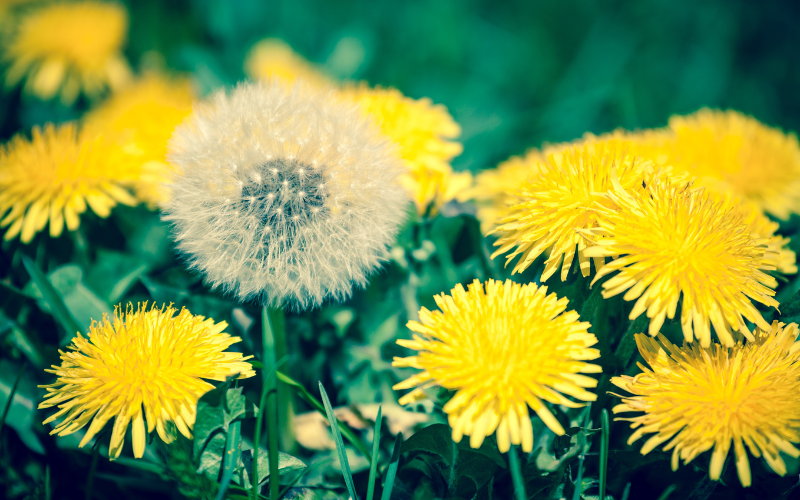The dandelion herb usually attracts attention for its delicacy, especially from children who like to blow it. However, did you know that this plant can have several uses? Learning how to plant dandelions can bring you many benefits.
The dandelion is easily found in any garden, park or sidewalk edge. However, growing the plant at home is a way to ensure that it grows free of pollution and suitable for consumption. To learn about the properties of this green and how to plant it, read on!
Knowing a little more about dandelion
Before we explain how to plant dandelions, we want you to know a little more about it. For starters, dandelion is the name used to refer to several plants in the genus Taraxacum . It encompasses several species, but the most common is Taraxacum officinale .
Native to Europe, the herb was brought to America by colonizers and today it can be found in different parts of the world. It prefers temperate or subtropical climates, but is highly adaptable and can survive in a variety of conditions.
Despite its beauty, it is considered an invasive plant. The rustic feature and spontaneous development allow it to grow in virtually any fertile, nutrient-rich soil. However, many are unaware of the uses and properties of the green green.
Dandelion is PANC and medicinal
Another curiosity about this herb is that it is an Unconventional Food Plant (PANC). Slightly bitter, the leaves can be eaten raw, sautéed or cooked. The flavor is similar to that of chicory, a closer relative, and can be substituted in some recipes.
Dandelion root and flower can also be used in cooking. The plant is still used to make beverages such as tea. In certain regions, it is ground and roasted to be used as a coffee substitute. In some countries, such as Canada, the herb still gives rise to a smoother type of beer than the common one.
The dandelion plant contains vitamins A and C, calcium, iron, high potassium and beta-carotene. These substances have a detoxifying action, acting directly on the liver and gallbladder, stimulated to eliminate waste from the body.
The herb’s properties are considered a herbal resource, especially by Chinese medicine. Therefore, it is used to treat tonsillitis, colds, ulcers and boils. Therefore, knowing how to plant dandelions brings health benefits and opens doors to gastronomic adventures.
How to plant?
Now that you know the characteristics and attributes of this plant, we can talk about how to plant dandelions. Cultivation is simple and does not require as many criteria, but certain care is necessary if you want to consume the herb.
Thinking about it, we prepared a step by step and some tips. Below you will find information about the soil and the amount of light and water to ensure that your greenery grows firm and strong.
1- Planting in a pot, flowerbed or garden
The first steps to start planting is to acquire the dandelion seed and place it in the soil. It is very important that you do not collect seeds from plants on streets or sidewalks, as they are exposed to pollution. Choose seeds from a garden supply store or a reputable garden.
In a vase, a flower bed or directly on the garden soil, it is necessary to prepare the soil to receive the seeds. The soil must have good drainage, be deep and rich in organic matter .
The vase must be up to 30 cm high. If you choose to plant in the ground, the distance between one seed and another must be 35 cm. Once the soil is in the right conditions, place the seeds in the chosen location and cover them with a small layer of soil.
2- Light and temperature
The dandelion is very strong and resistant, however, during the growth process, it does not accept direct sun. Therefore, the place chosen for planting should be located in partial shade. Under a tree or next to a wall are examples of spaces that will contribute to the development of the plant.
Regarding the planting time, the spring season is the best time. So you can harvest healthy leaves in late summer or mid-autumn. The plant develops even better if it is in regions above 25ºC.
3- Irrigation
The next step is watering. For the plant to develop, the soil needs to be always moist, but never soaked. Until the seeds sprout, water them every day. The best period is at the beginning or end of the day, when water evaporates less easily.
If you decide to plant the herb in a vase, choose a container with holes in the bottom to facilitate water drainage. Care must be taken to ensure that the containment dish and the surface of the vessel do not become caked.
4- Cultural treatments
The last step is to maintain the plant. This involves maintaining watering and removing invasive plants from the pot, as they can steal nutrients. Herb germination can take anywhere from five days to three weeks. Until this process is complete, do not pick leaves or flowers.
Harvest
The dandelion harvest can be done 90 days after planting. Dandelion root can only be harvested approximately 1 year after planting. In the case of flowers, which can be used to make tea, the best time to harvest is before 6 am.

